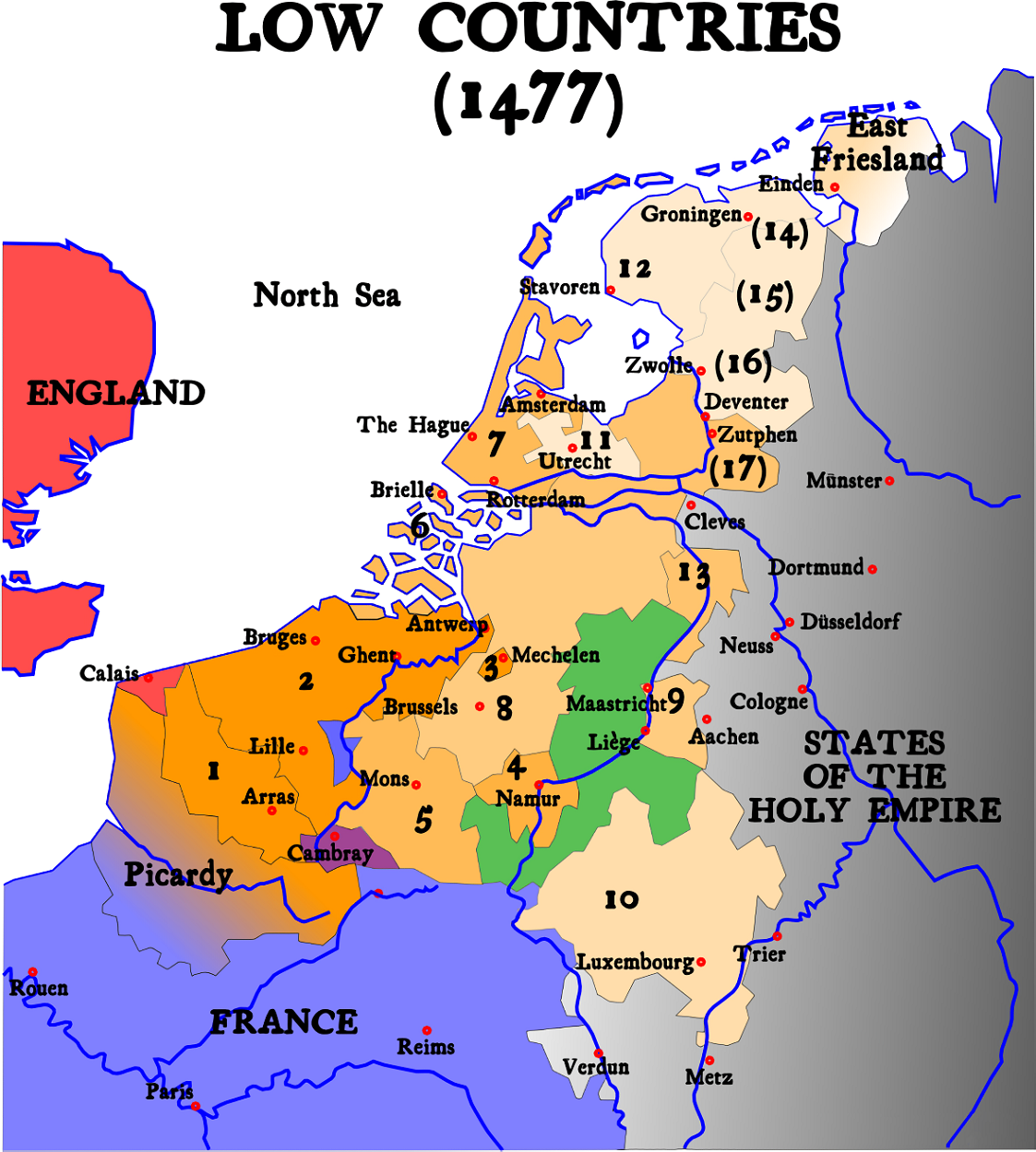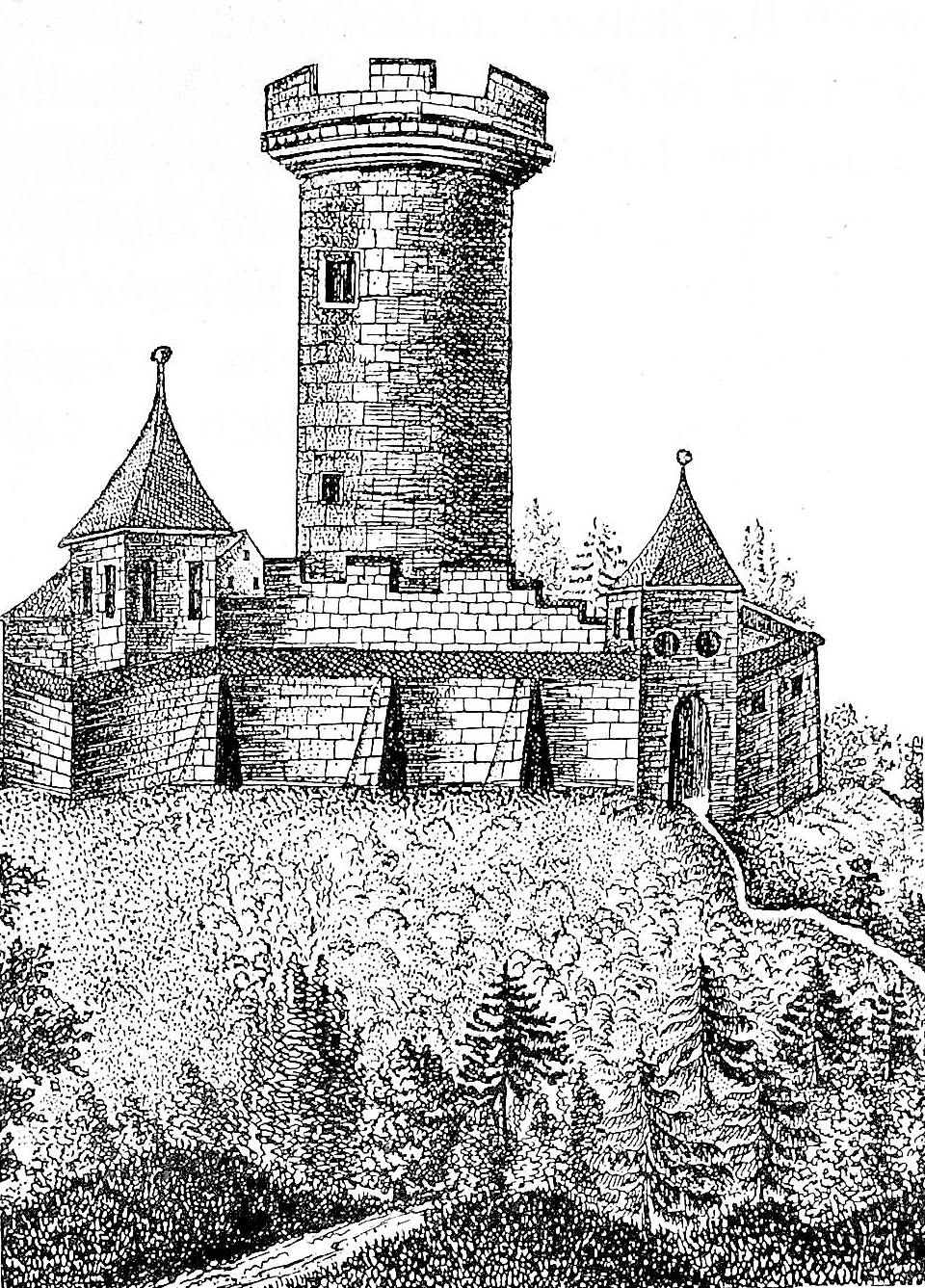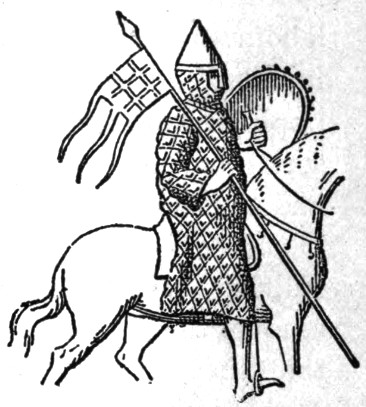|
Godfrey I Of Namur
Godfrey of Namur (attested in 1080; died 19 August 1139) was a Lotharingian nobleman. He was Count '' jure uxoris'' of Porcéan from 1097 until his death. From 1102, he was also Count of Namur. He was the oldest son of Count Albert III and his wife Ida of Saxony, the heiress of Laroche. In 1121, he founded Floreffe Abbey, where he also was buried. Marriages and issue Godfrey married twice. He first married in 1087 Sibylle, a daughter of Count Roger of Château-Porcien and his wife Ermengarde. Together, they had two daughters: * Elisabeth (fl. 1141), married Gervais, Count of Rethel and later Clarembaud de Roscy; * Flandrine, married Hugh of Épinoy. Sibylle and Godfrey divorced in 1105 because of her pregnancy by her lover Enguerrand I, Lord of Coucy. In 1109, Godfrey married Ermesinde (d. 24 June 1143), the daughter of Count Conrad I of Luxembourg and his wife Clementia. She was the widow of Count Albert I of Egisheim-Dagsburg and Moha. Together, they had the followin ... [...More Info...] [...Related Items...] OR: [Wikipedia] [Google] [Baidu] |
Counts Of Namur
The County of Namur was not often an independent state, rather under the dominion of other entities like the counties of County of Hainaut, Hainaut and County of Flanders, Flanders or the Duchy of Burgundy. Succession is from father to son, unless otherwise noted. Counts House of Namur * Robert of Namur (died 981), Robert I (r. 946 – 981) * Albert I, Count of Namur, Albert I (r. 992 – 1010) * Robert II, Count of Namur, Robert II (r. 1010 – 1018?) * Albert II, Count of Namur, Albert II (r. 1018? – 1067) * Albert III, Count of Namur, Albert III (r. 1067 – 1102) * Godfrey I, Count of Namur, Godfrey I (r. 1102 – 1139) * Henry IV of Luxembourg, Henry I ''the Blind'' (r. 1139 – 1189) ** Alice of Namur, Alice, sister of, married Baldwin IV, Count of Hainaut Marquises House of Flanders * Baldwin V, Count of Hainaut, Baldwin I (r. 1189 – 1195), nephew of * Philip I, Marquis of Namur, Philip I (r. 1195 – 1212) * Yolanda of Flanders, Yolanda (r.1212 – 1217), sist ... [...More Info...] [...Related Items...] OR: [Wikipedia] [Google] [Baidu] |
Trier
Trier ( , ; lb, Tréier ), formerly known in English as Trèves ( ;) and Triers (see also names in other languages), is a city on the banks of the Moselle in Germany. It lies in a valley between low vine-covered hills of red sandstone in the west of the state of Rhineland-Palatinate, near the border with Luxembourg and within the important Moselle wine region. Founded by the Celts in the late 4th century BC as ''Treuorum'' and conquered 300 years later by the Romans, who renamed it ''Augusta Treverorum'' ("The City of Augustus among the Treveri"), Trier is considered Germany's oldest city. It is also the oldest seat of a bishop north of the Alps. Trier was one of the four capitals of the Roman Empire during the Tetrarchy period in the late 3rd and early 4th centuries. In the Middle Ages, the archbishop-elector of Trier was an important prince of the Church who controlled land from the French border to the Rhine. The archbishop-elector of Trier also had great signific ... [...More Info...] [...Related Items...] OR: [Wikipedia] [Google] [Baidu] |
Frederick Barbarossa
Frederick Barbarossa (December 1122 – 10 June 1190), also known as Frederick I (german: link=no, Friedrich I, it, Federico I), was the Holy Roman Emperor from 1155 until his death 35 years later. He was elected King of Germany in Frankfurt on 4 March 1152 and crowned in Aachen on 9 March 1152. He was crowned King of Italy on 24 April 1155 in Pavia and emperor by Pope Adrian IV on 18 June 1155 in Rome. Two years later, the term ' ("holy") first appeared in a document in connection with his empire. He was later formally crowned King of Burgundy, at Arles on 30 June 1178. He was named by the northern Italian cities which he attempted to rule: Barbarossa means "red beard" in Italian; in German, he was known as ', which means "Emperor Redbeard" in English. The prevalence of the Italian nickname, even in later German usage, reflects the centrality of the Italian campaigns to his career. Frederick was by inheritance Duke of Swabia (1147–1152, as Frederick III) before his i ... [...More Info...] [...Related Items...] OR: [Wikipedia] [Google] [Baidu] |
Ithier, Count Of Rethel
Guitier (Ithier) of Rethel (died 1171), son of Odo of Vitry and Matilda, Countess of Rethel, nephew of Baldwin II of Jerusalem, was Count of Rethel, succeeding his mother. (His father is named as count, but it is not clear that he ever served.) Châtelain de Vitry. In March 1129, Guitier travelled to the Holy Land, although it is not clear if he participated in the Damascus Crusade that year. Guitier married Beatrix of Namur, daughter of Godfrey I, Count of Namur, and Erminside. Guitier and Beatrix had eleven children: * Beatrix de Rethel (1130 – 30 March 1185), married Roger II, King of Sicily * Jean de Rethel (died after 1144) * Manasses de Rethel (died after 1144) * Hugues de Rethel (died after 1166), monk at Reims * Manasses IV (died 1199) * Henri de Rethel (died 1191), Châtelain de Vitry * Baudouin de Rethel (died 1198 or after), Seigneur de Chemery * Albert de Rethel (died 1195 or after), Archdeacon at Liège * Simon de Rethel * Clemence de Rethel (died after 119 ... [...More Info...] [...Related Items...] OR: [Wikipedia] [Google] [Baidu] |
Baldwin IV, Count Of Hainaut
Baldwin IV (1108 – 8 November 1171) was count of Hainaut from 1120 to his death. Baldwin IV was the son of Count Baldwin III of Hainaut and Yolande de Wassenberg.Gislebertus (of Mons), ''Chronicle of Hainaut'', transl. Laura Napran, (The Boydell Press, 2005), 40. Also known as Baldwin the Builder, he purchased the property of Ath in 1158 and built the Burbant tower. He ceded the locality of Braine-la-Willotte, also known as Braine-le-Comte, to the chapter of Sainte-Waudru in 1158. In 1159, he incorporated the seigniory of Chimay and in 1160 the châtellenies of Valencians and of Ostrevent. Baldwin IV married Alice, heiress of Namur, and had the following children: * Yolande (1131–1202), married first to Ivo II, Count of Soissons, and second to Hugh IV, Count of St Pol * Baldwin (1134–1147) * Agnes (1142–1168), married Ralph I, Lord of Coucy and had children including Yolande de Coucy, wife of Robert II, Count of Dreux. * Geoffrey, Count of Ostervant (1147–1163), fi ... [...More Info...] [...Related Items...] OR: [Wikipedia] [Google] [Baidu] |
Alice Of Namur
Alice of Namur (died July 1169 at Valenciennes) was the daughter of Count Godfrey I of Namur and Countess Ermesinde of Luxembourg. Her father married her off to Count Baldwin IV of Hainaut around 1130. Gislebert of Mons described her as having "a graceful body and a beautiful face". Their son Baldwin was the heir of Namur when her brother Count Henry IV of Luxembourg died in 1196. Her children with Baldwin IV of Hainaut were: *Yolande (1131/5 – after 1202), wife of Count Ives II of Soissons, and Count Hugh IV of Saint PolGislebert of Mons, ''Chronicon Hanoniae'' 34 (= L. Vanderkindere (ed.), 1904, p67, Alberic of Trois-Fontaines, ''Chronica s.a.'' 1168 (= L. Weiland (ed.), ''Monumenta Germaniae Historica, Scriptores'' XXIII, Hannover, 1874, p). *Baldwin (1134 – 1147/50)Gislebert of Mons, ''Chronicon Hanoniae'' 34 (= L. Vanderkindere (ed.), 1904, pp66 [...More Info...] [...Related Items...] OR: [Wikipedia] [Google] [Baidu] |
House Of Zähringen
The House of Zähringen (german: Zähringer) was a dynasty of Swabian nobility. The family's name derived from Zähringen Castle near Freiburg im Breisgau. The Zähringer in the 12th century used the title of Duke of Zähringen, in compensation for having conceded the title of Duke of Swabia to the Staufer in 1098. The Zähringer were granted the special title of Rector of Burgundy in 1127, and they continued to use both titles until the extinction of the ducal line in 1218. The territories and fiefs held by the Zähringer were known as the 'Duchy of Zähringen' (), but it was not seen as a duchy in equal standing with the old stem duchies. The Zähringer attempted to expand their territories in Swabia and Burgundy into a fully recognized duchy, but their expansion was halted in the 1130s due to their feud with the Welfs. Pursuing their territorial ambitions, the Zähringer founded numerous cities and monasteries on either side of the Black Forest, as well as in the western S ... [...More Info...] [...Related Items...] OR: [Wikipedia] [Google] [Baidu] |
Conrad I, Duke Of Zähringen
Conrad I ( – 8 January 1152) was Duke of Zähringen from 1122 until his death and from 1127 also Rector of Burgundy. He spent most of his life stemming the growing power of the House of Hohenstaufen and to this end, allied himself with the House of Guelph. Life Conrad I was a son of Duke Berthold II and his wife, Agnes of Rheinfelden. In 1120, Conrad I and his elder brother Berthold III granted city rights to Freiburg. In 1122, Conrad I succeeded Berthold III as Duke of Zähringen. In 1127, he came into conflict with Count Reginald III of Burgundy, because both men claimed the inheritance of Conrad's murdered nephew William III. In this situation, he benefitted from the situation Emperor Lothar III found himself in. Lothar urgently needed support against his Hohenstaufen rivals, and he supported Conrad's claim. He rejected Reginald's claim, with the dubious argument that Reginald had failed to comply with his duty to attend the emperor's court. Conrad received th ... [...More Info...] [...Related Items...] OR: [Wikipedia] [Google] [Baidu] |
Henry I, Count Of Guelders
Henry I, Count of Guelders (1117–1182) was Count of Guelders from 1131 until 1182. He was a son of Gerard II of Guelders and Ermgard of Zutphen. In 1138 Hendrik inherited the County of Zutphen from his mother. Hendrik was under tremendous pressure from the Bishopric of Utrecht and the County of Holland, and was forced by Holland to negotiate a treaty with the city of Utrecht Utrecht ( , , ) is the fourth-largest city and a municipality of the Netherlands, capital and most populous city of the province of Utrecht. It is located in the eastern corner of the Randstad conurbation, in the very centre of mainland Neth ...; this led to a problematic relation with the Bishop of Utrecht. In 1135 Hendrik married Agnes of Arnstein, daughter of count Louis III of Arnstein. Their daughter Adelaide married Gérard II, Count of Looz. Hendrik died in 1182 and was succeeded by his son Otto I of Guelders. He is buried at Kloosterkamp, probably the prestigious Cistercian abbey of ... [...More Info...] [...Related Items...] OR: [Wikipedia] [Google] [Baidu] |
Henry II, Duke Of Limburg
Henry II ( – August 1167) was the duke of Limburg from 1139 and count of Arlon from 1147 to his death. He was the son of Waleran, Duke of Lower Lorraine, and Jutta of Guelders, daughter of Gerard I of Guelders. He succeeded his father in Limburg with the title of duke, but Conrad III refused to grant him Lower Lorraine. He continued to style himself as duke nevertheless. Life Henry refused at first to accept the loss of Lorraine and in 1140 attacked the new duke, Godfrey VII. He was defeated. Godfrey died in 1142, but Henry was occupied with a war against the lord of Fauquemont and did not assert any claim to the duchy of Lower Lorraine. In 1147, he inherited Arlon, his younger brother Waleran having died without children. Conrad confirmed this, for he had promised Henry a fief to compensate for the loss of Lorraine, and the duke and the king were reconciled. Henry did not take part in the Second Crusade that year, however. Henry attended the coronation of Conrad's succes ... [...More Info...] [...Related Items...] OR: [Wikipedia] [Google] [Baidu] |
Ralph I, Count Of Vermandois
Ralph I of Vermandois ( French: ''Raoul Ier'') (d. 14 October 1152) was Count of Vermandois. He was a son of Hugh, Count of Vermandois and his wife, Adelaide, Countess of Vermandois. Ralph was a grandson of Henry I of France, while Ralph‘s mother had been the heiress to Herbert IV, Count of Vermandois. Ralph’s paternal uncle was Philip I of France. Through him Ralph was a first cousin of Louis VI of France and a first cousin once removed of Louis VII of France. Ralph served as the seneschal of France during the reign of Louis VII. Under pressure from the queen, Eleanor of Aquitaine, Louis allowed Ralph to repudiate his wife, Eleanor of Champagne, sister of Stephen, King of England, in favor of Eleanor of Aquitaine's sister, Petronilla of Aquitaine. This led to a war with Theobald II of Champagne, who was the brother of Ralph's first wife Eleanor. The war lasted two years (1142–44) and ended with the occupation of Champagne by the royal army. Ralph and Petronilla were excom ... [...More Info...] [...Related Items...] OR: [Wikipedia] [Google] [Baidu] |
Aalst, Belgium
Aalst (; french: Alost, ; Brabantian dialect, Brabantian: ''Oilsjt'') is a City status in Belgium, city and Municipalities in Belgium, municipality on the Dender River, northwest from Brussels in the Flemish Region, Flemish Provinces of Belgium, province of East Flanders. The municipality comprises the city of Aalst itself and the villages of Baardegem, Erembodegem, Gijzegem, Herdersem, Hofstade, Meldert, Moorsel and Nieuwerkerken. Aalst is crossed by the Molenbeek-Ter Erpenbeek in Aalst and Hofstade. The current mayor of Aalst is Christoph D'Haese, from the Nieuw-Vlaamse Alliantie, New-Flemish Alliance party. The town has a long-standing (folkloric) feud with Dendermonde (north along the river), which dates from the Middle Ages. History The first historical records on Aalst date from the 9th century, when it was described as the ''villa Alost'', a dependency of the Abbey of Lobbes. During the Middle Ages, a town and port grew at this strategic point, where the road from Bruges ... [...More Info...] [...Related Items...] OR: [Wikipedia] [Google] [Baidu] |



